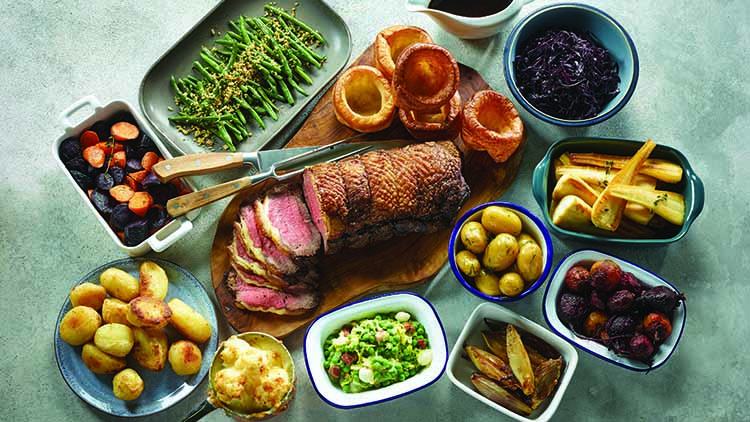Researchers at Portsmouth University in the UK claim that eating a roast dinner, or equivalent meal, every day would be the equivalent of eating two plastic bags a year.
The shocking claim was aired on the British TV show, Good Morning Britain, and is yet more alarming evidence of the extent of microplastic pollution of the food chain.

Microplastics in roast dinners: shocking new research
'The were 6 times more microplastics in the potatoes that were wrapped in plastic compared to the fresh potatoes'
— Good Morning Britain (@GMB) November 28, 2022
Pollution expert, Professor Fay Couceiro shares that eating the equivalent of one roast dinner everyday would equate to eating two plastic bags each year pic.twitter.com/jwb8YAuBES
Good Morning Britain reporter Michelle Morrison made two identical roast dinners (chicken, potatoes, carrots, broccoli, and Yorkshire puddings) for the researchers to test, one with pre-packaged goods and the other with goods that mostly came without plastic packaging.
The roast dinner made with packaged ingredients had seven times the amount of plastic in it than the meal that was made with mostly unpackaged ingredients.
Dr. Faye Coucerio, an expert from Portsmouth University, said: “It would appear that the majority of microplastics in our food come from the plastic packaging it is wrapped in.
“However, there are other ways that plastic can enter the food chain. It could be getting into the vegetables through the soil or into our meat through grazing.
Air has lots of microplastics in it too so they could be falling on top of the food. And finally, it could be from the cooking utensils used when preparing a meal.”
“Usually food samples are analysed for microplastics in their raw state under laboratory conditions.
“This study differs because we chose to look at what was actually on your plate after the food had been cooked.
“Instead of a sterile laboratory, the food was cooked in a normal kitchen so it is likely the microplastics will come from a combination of within the food, the packaging, cooking utensils and the air.”
Microplastics: bad things come in small packages

In recent months, as part of our ongoing spotlight on the harmful industrial and natural chemicals that are playing havoc with our health, we’ve written about microplastics on a number of occasions.
Microplastics – tiny pieces of plastic that are either designed to be that size or become so through weathering – act as vectors for harmful xenoestrogens, as well as causing physical damage to organisms, especially microorganisms and juvenile organisms like baby fish.
The scale of the problem is already mind-boggling. Scientific models now suggest that microplastics are so ubiquitous that they are circulating like a ‘force of nature’, reaching the most remote places – even places humans have never set foot before.
In one recent study, researchers at the New York University School of Medicine compared stool samples from newborns, infants and adults to ascertain concentrations of two different kinds of plastic in them. All of the subjects were from New York State.
First of all, they noticed that all of the samples contained at least one of the two types of microplastic they were looking for. This shouldn’t be surprising, given what we already known about the ubiquity of these substances.
The real shock came when they compared the baby samples to those of the adults. In the baby samples, there were at least TEN times as much microplastic. Yes, that’s right: TEN times.
So how could this be happening?
The researchers believe that the way babies are consuming such high levels of microplastics is through chew-toys like dummies and from crawling around on carpets that contain microplastics.
It’s worth noting, too, that microplastics have already been found in the placentas of mothers, raising the prospect that some of the microplastics found in the babies in the sample could have been passed to them by their mothers.
Although scientists once believed microplastics would just pass through the gastrointestinal tract without causing any harm, recent research suggests the smallest pieces are able to cross cell membranes and enter our circulation.
This is an obvious cause for concern, and all the more so because research on microplastics in lab animals has caused cell death, inflammation and metabolic disorders.
Human research is also beginning to substantiate these potential harms. A new study has shown, for instance, that microplastics can alter the shape of human lung cells and affect their functioning.
Don’t hesitate to email us at [email protected] for personalized coaching and a client questionnaire if you’d like DEDICATED tailor-made personal training on strength training, building muscle, losing fat, developing athleticism, and more — all to your liking, lifestyle, habits, and taste!
Otherwise, don’t forget to claim your FREE eBook detailing how to lose 20lb of fat while building muscle in 12 weeks! You can claim it here.
Alternatively, you can pick up a FREE eBook on fundamental strength principles offering an introductory workout program.











